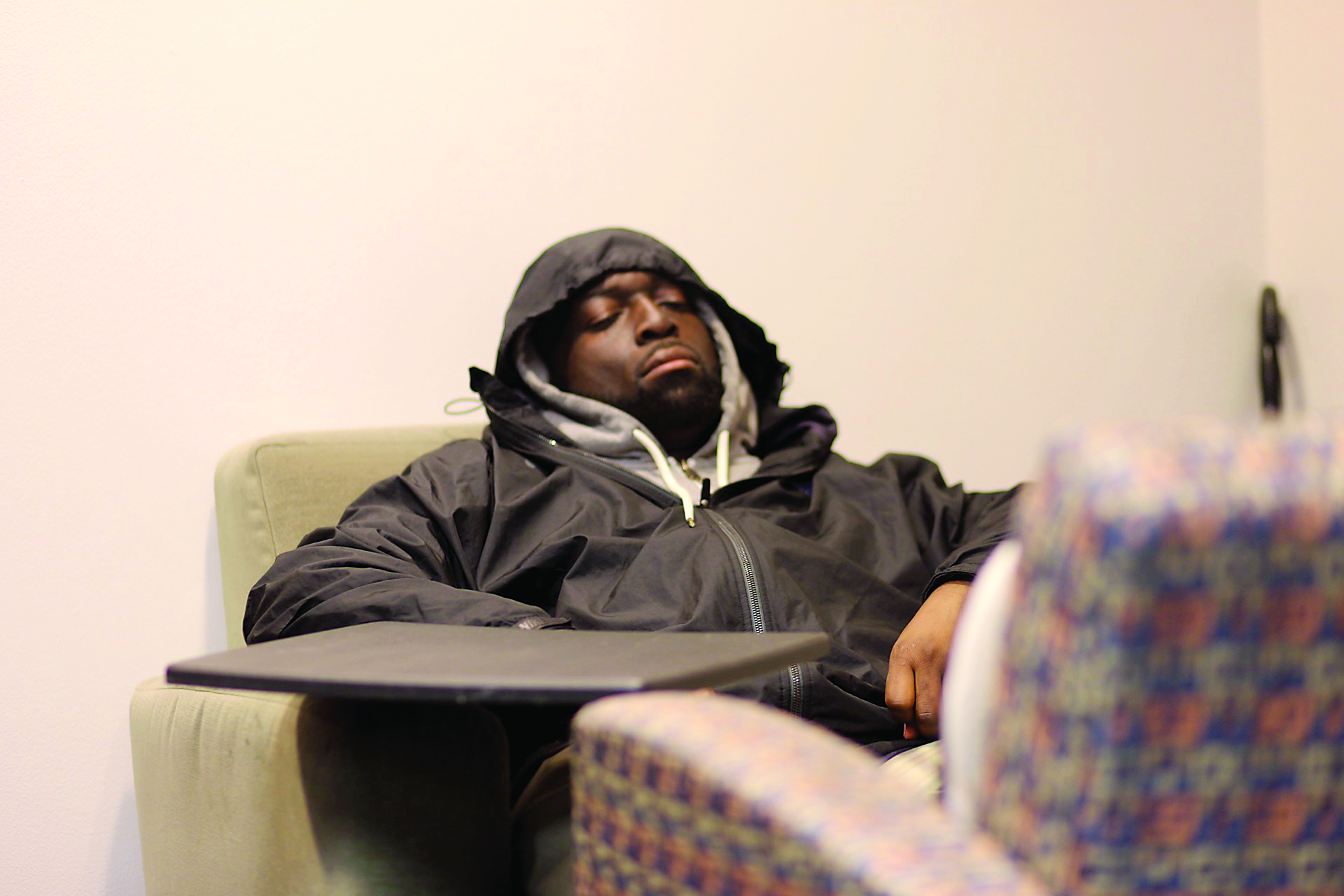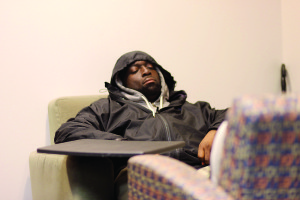

Photos by Dayne Francis | The Signal
Snotti St. Cyr, Georgia State junior exercise science major, lives in the Lofts now. But the 31-year-old Brooklyn native spent nine years unable to keep a job, fighting with family and “jumping from couch to couch” during stints of homelessness after he was expelled from Georgia State in 2005.
“If I’m living with friends for an extended amount of time, jumping from couch to couch, or living on the street, I define that as homelessness,” St. Cyr said.
A homeless person is defined as one who lacks permanent housing, lives on the street, a shelter, mission, single room occupancy facilities, abandoned building or vehicle, according to the National Health care for the Homeless Council.
In January 2015, the Continua of Care, a collection of Georgia’s nine homeless program regions, counted homeless families and individuals called the “Point in Time Count.” The count totaled nearly 13,790 homeless people in Georgia, according to the Georgia Department of Community Affairs 2015 Report on Homelessness.
Prince, the Pauper
St. Cyr said a friend moved him into a vacant home during the summer of 2015. St. Cyr had no idea he was a squatter at that time, and the property manager made him leave soon after potential buyers showed up.
“I went to Atlanta Legal Aid and the Georgia Center for the Homeless [after that incident], and Atlanta Legal Aid said Georgia doesn’t really have laws to protect squatters,” he said.
St. Cyr said he went to at least five different staffing agencies, several job networking sites and fitness centers for work. He also said he had a job he couldn’t keep because of his living arrangements and his lack of a cell phone.
“There was one lady who offered me a job paying at least $12 an hour, plus benefits,” he said. “In 2013, she gave up because she couldn’t contact me.”
St. Cyr took advantage of food banks and non-profits, such as United Way and Georgia State’s Panther Pantry, in lieu of a meal plan. He said “logistics and word of mouth” are crucial to finding food while homeless.
“I’ve heard through word of mouth, from other homeless people, during the summer nearly 200 people would camp out at Hurt Park to receive food from church members. I was one of them,” he said.
St. Cyr said he hasn’t forgiven himself for the mistakes he made during his first college attempt. He, like many college students, receives financial aid from Georgia State, and he is also applying for government programs like Medicaid and food stamps.
“If I had one decent paying job, and able to save money throughout the entire nine year period, who knows where I would have been?” he said.
The signs
There are obvious tell-tale signs that a person is homeless, according to Youth Today. The person may be carrying several bags, wearing dirty clothes or charging cell phones in public places.
St. Cyr had to limit how many bags he carried around campus and usually found places to hide his things. He relied on friends for a place to clean himself and did his best to come to class clean and to maintain a strict study schedule.
“I had a friend who let me use her office to take a shower,” he said. ”Being homeless is also about logistics, being confident and maintaining some sense of dignity.”
Many people who are homeless experience some type of vulnerability, such as family violence, physical disability, mental illness or criminal background, according to the 2015 Report on Homelessness.
St. Cyr said he reached out to the Dean of Students office, and received help from Fallon Proctor, Georgia State coordinator for Student Advocacy and Outreach,
“We developed a plan together,” he said. “She talked to some of the peers in her office, and contacted the housing department to help me, compiling information about soon-to-be available rooms.”
Proctor said the Office of the Dean of Students offers referrals to on and off campus programs based on student need.
“Some examples include community organizations that provide housing assistance, the Counseling and Testing Center, Emergency Withdrawal process or the Panther Pantry,” she said.
St. Cyr was diagnosed with clinical depression and body dysmorphic disorder in 2005, saying he felt “like he had no discernible purpose or support system.” He also said in 2009 and 2012, he considered suicide.
“I just felt like a failure,” he said. “I felt like I was letting everyone down, and I was crying myself to sleep and waking up with tears in my eyes.”
African Americans comprise about 65 percent of the homeless population in Georgia, 64 percent of the population are men, according the 2015 report.
St. Cyr said he has lived with over 15 family members and several family friends while homeless, and has severed ties with most of his immediate family, including his mother and two sisters, one of which he fought with before cutting ties with her.
“My sister kept asking me when was I going to get my life together,” he said. “We actually got into a physical altercation in 2005, and I ended up in the hospital [with injuries] and had to cancel a job interview.”
Homeless youth update
During the summer of 2015, Georgia State sociology professor Eric Wright and his students conducted a count of the underrepresented homeless youth, called Atlanta Homeless Youth Count and Needs Assessment.
Initially, Georgia counted the homeless youth as being at least 1,000 in the state, but Wright thinks it may be over 2,500, according to Creative Loafing.
Wright said the data is still being analyzed, so the report isn’t completed, instead of the November 2015 date of completion.
“We don’t want to make any mistakes. We’ve collected so much data, it won’t be ready for another few weeks,” he said.
Proctor said the number of students that have reached out to the Office of the Dean of Students for assistance are still being calculated.
“We are still in the first year of formally collecting data so there is no information available at this time,” she said.
St. Cyr said he noticed Georgia State conducting their count last summer while he was homeless. He said he was never approached, but he knew about it from a friend involved with the project, who is also homeless.
“I saw two or three people doing that project,” he said. ”He [the friend] told me about what type of people he was looking for and about his approach.”
St Cyr’s numerous future plans include getting straight A’s this spring semester, graduate school, and helping athletes develop better financially. He is also writing about his homeless experiences.
“I want to become a licensed physical trainer in three to five years,” he said. I want to work with high school and college athletes, and help them become more financially responsible.”
